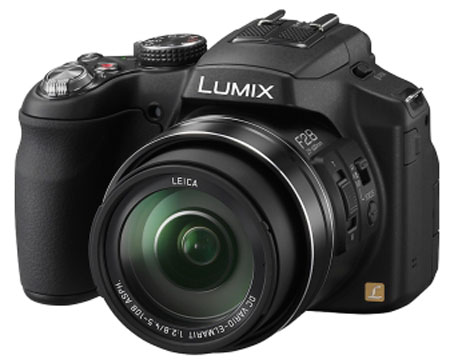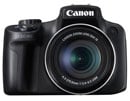Panasonic Lumix FZ200 review
-
-
Written by Ken McMahon
Verdict
The Lumix FZ200, Panasonic’s Flagship super-zoom, marks a turn in the road for the FZ range and maybe even for the Super-zoom market generally. Rather than continue striving to produce ever longer zoom ranges with increasingly powerful telephoto focal lengths, Panasonic has taken a time out and thought of other ways of improving things. The result is one of those things that looks obvious in restrospect, but in truth takes a company with vision to bring about. The Lumix FZ200’s killer feature is its f2.8 constant aperture lens.
It has become a super-zoom fact of life that when you zoom in the aperture significantly slows down. This lets in less light and forces high ISOs or slow shutter speeds, neither of which are conducive for either optimal image quality or freezing the action on sports and wildlife shots respectively. Many people buy these cameras hoping to use their massive zooms for sports and wildlife, but end up finding they’re mostly only suitable for static subjects. The FZ200 with its constant f2.8 aperture combined with excellent stabilisation changes all that.
While most other manufacturers continue to offer basic low resolution electronic viewfinders, the FZ200’s 1.3 million dot EVF provides a detailed, comfortable view that outclasses similarly priced models form other manufacturers. Only the Fujifilm HS30 EXRs 920k EVR comes close to matching it. The FZ200’s improved 12.1 Megapixel sensor produces great quality JPEGs with the option to Shoot RAW and new HD miniature and High Speed Motion Video modes add to an already comprehensive selection of HD video options.
It adds up to a very capable and well rounded package that, while it may not win any awards for the biggest, longest or smallest, super-zoom, has the brightest lens of any camera in its class backed up by a set of features that will be appreciated by those prepared to look beyond the headline features of zoom range and Megapixel count.
 |
Compared to Canon PowerShot SX50 HS
The Panasonic Lumix FZ200 and Canon PowerShot SX50 HS share a number of things in common beyond their appearance, but lets start with that. Both are closely matched in terms of size and weight and have quite similar styling, especially now the SX50 HS has been ‘squared up’. On the inside, both have 12 Megapixel sensors and both now offer RAW shooting in addition to JPEG modes. Despite the different specifications, their articulated LCD screens are similarly sized and share the same 460k dot resolution. And they offer a similar range of manual, semi, and fully automatic exposure modes.
So much for the similarities, there are a lot of differences too, let’s start with the most obvious one. The PowerShot SX50 HS has twice the zoom range of the Lumix FZ200. They start at similar 24mm and 25mm wide angles respectively, but the SX50 HS goes all the way to 1200mm where the FZ200 stops at 600mm. The comparison makes the FZ200 sound puny, but 600mm is still a very long telephoto and will get you close enough to most things. Where the SX50’s extra reach will come in handy is for photographing small things that are a long way off, like birds, or, who knows, maybe even celebrities. While we’re on the subject of lenses, it’s equally important to note the Lumix FZ200’s zoom has a fixed f2.8 aperture, compared with f3.4-6.5 on the SX50 HS. This not only makes the FZ200 more capable in low light, with a two stop advantage over the SX50 HS when zoomed in, it means it’s possible to achieve more shallow depth of field for portraiture and medium to long telephoto shots.
Though their screens are similar, the Lumix FZ200’s elecronic viewfinder has a higher resolution than the SX50 HS’s and provides a brighter, more detailed and ultimately more comfortable view. And the FZ200 provides a button for toggling between the screen and EVF. All of which adds up to a better all-round viewing and handling experience than on the SX50 HS.
The FZ200 features a greater abundance of physical controls than the SX50 HS and provides more customisation options. There are no fewer than three programmable Fn buttons, as well as a barrel switch for focus mode selection. There’s also a dedicated button for selecting continuous shooting modes and the FZ200 offers a wider range of burst options.
Both cameras have a dedicated movie record button, are able to use thier optical zooms during recording. The Lumix offers a best quality 1080p50/60 option compared with 1080p24 on the SX50 HS. While film fans love the film-like quality of 24p video, the 50/60p mode on the FZ200 provides the scope for high quality slow motion playback at 25/30fps. Both offer two slow motion movie modes, but the FZ200’s is HD resolution compared with VGA on the SX50 HS. Both cameras have a standard hotshoe as well as the built-in flash, but the FZ200 additionally provides a socket for an external mic.
In terms of image qualiy, there’s little to choose between these two models, and now that the SX50 HS can shoot RAW, we can say that applies to both the in-camera JPEGS as well as RAW files. Finally, depending on where you are in the World, the PowerShot SX50 HS will cost you up to around 25 percent less than the Lumix FZ200.
Price aside, these differences mean the choice really comes down to what features are most important to you. The Canon offers unmatched zoom range together with some great creative modes and versatile video options and, now, the ability to process your own RAW files. But in many ways, the FZ200 still provides more for enthusiasts to get their teeth into. The lens may lack the Canon’s range, but its wider aperture provides more opportunities for sports, wildlife, low light shots and for creative depth of field effects. Its viewfinder is better than the SX50’s and it offers more customisation options. If those advantages add up to more than the zoom reach, you’ve got your answer.
Check out my Canon PowerShot SX50 HS review for more details.
Panasonic Lumix FZ200 final verdict
The Lumix FZ200 is Panasonic’s Flagship Superzoom and is worthy of the title. If extreme telephoto power is what you’re looking for there are plenty of other models out there that passed the 24x marker a good while back and are now well beyond what the FZ200 has to offer. But if you were the kind of person who judged a super-zoom purely on the basis of its zoom range, you probably wouldn’t be reading this. Zoom range is only one aspect of what the FZ200 has to offer, a 600mm telephoto will be more than enough reach for most people and the FZ200 has much more to recommend it besides.
A long lens is only any good if there’s enough light for you to use it and the FZ200’s constant f2.8 aperture makes that more likely to be the case more often. In stadiums, at twilight, or just on plain dull days, you’ll be taking better quality 200 ISO long shots with the FZ200 instead of 800 ISO ones with, say, the Canon SX50 HS; or if both are using the same ISO, the Panasonic will enjoy faster shutter speeds to freeze the action. The high resolution EVF makes it easier and more comfortable to frame shots and a button makes it easy to flip between the viewfinder and screen, though a proximity sensor to make it happen automatically would be better. Add in a great range of video options with the ability to attach an external microphone, a wide range of exposure modes and effects filters, excellent customisation options and physical controls and extremely good battery life and it’s hard to think of any reason the Lumix FZ200 wouldn’t come Highly Recommended.
(One final thing worth noting is that Pansonic also produces a more affordable version of the FZ200. The Lumix FZ60 / FZ62 shares the same 25-600mm zoom range, but with a differrent 16.1 Megapixel MOS sensor and lacking many of the FZ200’s features, most notably, the f2.8 constant maximum aperture, high resolution electronic viewfinder, articulated screen, RAW files, hotshoe, mic input and 1080p60/50 video. That might sound like you’re missing out on a lot, but bear in mind the FZ60 / FZ62 is a little over half the price of its more capable sibling. Check out my Panasonic FZ60 / FZ62 review to find out more.)
Bad points | Scores (relative to 2012 super-zooms) |
 | ||
Build quality: Image quality: Handling: Specification: Value:
Overall: |
17 / 20 17 / 20 18 / 20 18 / 20 16 / 20
85% | |||





